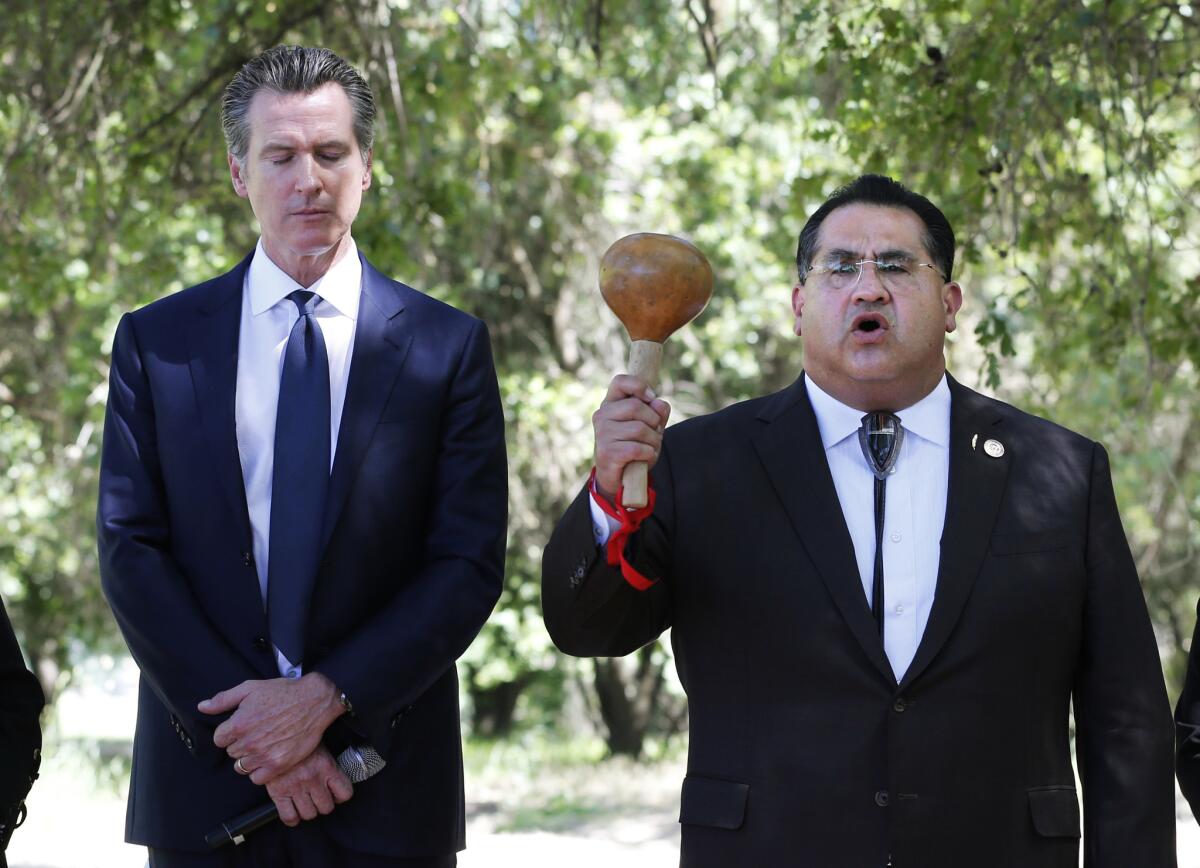Capitol Journal: In Newsom’s apology to Native Americans, California finally acknowledges the bigotry of its past

- Share via
Reporting from Sacramento — In a Time Life book titled “The Indians of California,” there’s a passage that probably isn’t taught to schoolchildren studying our not-so-golden state’s checkered history.
It reads:
“One old Pomo woman looked on in horror as two whites impaled a little girl on the bayonets of their guns and tossed the body in the water. [She] saw a little boy and a mother and baby put to death in similar fashion. One man was strung up by a noose and a large fire built under him….”
That happened on what soon became known as Bloody Island at Clear Lake, 90 miles north of San Francisco.
There’s a historical marker that reads: “On this island in 1850, U.S. soldiers nearly annihilated all its inhabitants for the murder of two white men. Doubt exists of these Indians’ guilt.”
There’s no doubt two white ranchers were killed by a handful of Indians. The ranchers had enslaved, tortured and starved the Indians. They were planning to force-march the “surplus” — those unfit or unneeded for ranch labor — to Sutter’s Fort in the Sacramento Valley 100 miles away. A final straw was when the ranchers captured the chief’s young wife and forced her to live with them.
After the chief and some buddies killed the two ranchers, the U.S. Army retaliated by massacring much of the Pomo tribe. The commander wrote his general: “The number killed I confidently report at not less than 60, and doubt little that it extended to 100 and upwards.”
On Tuesday, 169 years later, California’s governor finally apologized for the likes of Bloody Island.
Technically, state government wasn’t the assassin at Clear Lake. The U.S. Cavalry was. California was still four months short of official statehood. But the carnage unquestionably reflected the prevailing California political sentiment.
The 2020 census is coming.Will Native Americans be counted? »
The next January, California’s first elected governor, Peter Burnett, declared in his State of the State address: “That a war of extermination will continue to be waged between the two races until the Indian race becomes extinct must be expected.”
In the 1850s, the Legislature appropriated $1.29 million to wage militia war against California’s Native Americans. Some of that money was used to pay bounties for body parts — 25 cents per scalp, up to $5 for a whole head.
California’s indigenous population exceeded 200,000 in 1800, but plummeted to around 15,000 by 1900.
“It’s called a genocide,” Gavin Newsom said at a ceremony with Native American leaders along the Sacramento River in 103-degree heat. “That’s what it was. A genocide. No other way to describe it and that’s the way it needs to be described in the history books….
“You have to call things what they are…. We allowed vigilantes. We organized militias. We funded them. We reimbursed them and we got the federal government to make us whole. That was genocide….
“And so,” he concluded, “I’m here to say the following: I’m sorry on behalf of the state of California.”
OK, but so what? Why now? And what good does it do?
For starters, why not?
It does mean that California’s government finally acknowledges that a significant number of the state’s early elected officials and pioneer citizens were a bunch of greedy, bigoted thugs. It’s healthy to admit that.
We’ve never been reluctant to demand that Southern whites face up to their shameful history of enslaving, segregating and lynching African Americans.
“It’s definitely overdue,” Newsom senior advisor Daniel Zingale replied when I asked what prompted the governor’s apology. “It’s the kind of thing he wanted to address early on. It’s on his list of core values.”
Another thing it does: It makes the Democratic governor lots of wealthy friends who run tribal casinos and have vaults full of potential campaign donations when he eventually runs for president.
Actually, I figure, most California voters partially apologized in 1998 and 2000 by allowing tribes to build Vegas-style casinos on their rural reservations. There are now 64 casinos operated by 62 tribes.
No one seems to know — at least publicly — how much in winnings they pull in each year. But it’s in the many billions of dollars.
The governor’s apology apparently means a lot personally to Native American leaders.
“It’s instrumental,” says Assemblyman James Ramos (D-Highland), the first California Indian elected to the Legislature. “Sometimes local elected officials don’t really believe what happened to us. It’s just ‘our story.’ So having the leader of the state of California come out and give an apology, it’s instrumental.”
Ramos, who grew up on the San Manuel Indian Reservation, talks about the “Battle of 1866.” White militia forces swarmed into the San Bernardino Mountains to clear out the Indians. His great-great-grandfather, Ramos says, saved the last 30 tribal members and founded the San Manuel reservation in the valley.
“There’s the same story of genocide over gold and logging throughout the state,” he says. “Tribes were pretty much annihilated.”
Now California has the largest American Indian population in the country — around 723,000.
This state, of course, also has a bigoted, greedy history toward Asians. For generations, Japanese immigrants were barred from owning property. The Chinese couldn’t legally migrate here at all.
But California Indians were the only ones systematically killed with Sacramento’s financial support.
If Newsom is ever elected president, he can offer the nation’s apology for all the atrocities inflicted on Native Americans by European invaders — including at the Trail of Tears, Wounded Knee and Bloody Island.
Follow @LATimesSkelton on Twitter
More to Read
Get the L.A. Times Politics newsletter
Deeply reported insights into legislation, politics and policy from Sacramento, Washington and beyond. In your inbox three times per week.
You may occasionally receive promotional content from the Los Angeles Times.











